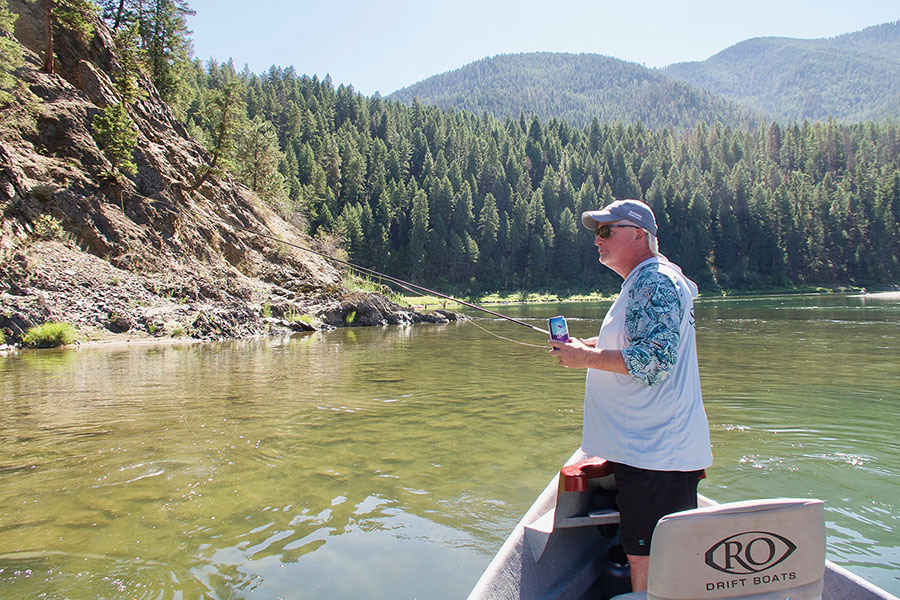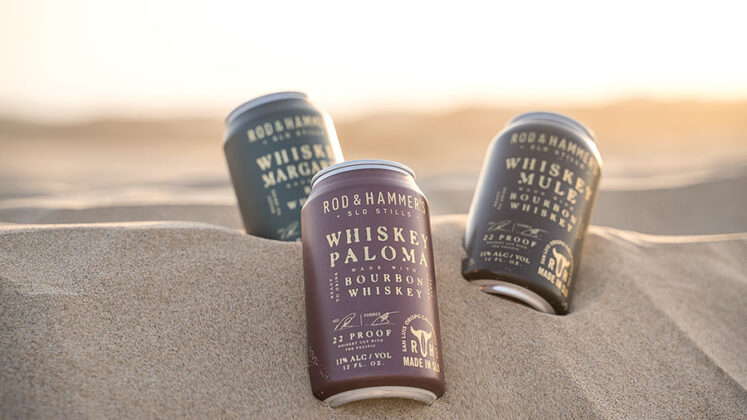
Don Poffenroth’s drift boat is gliding into the center of Clark Fork River, a tributary of the Columbia just below Montana’s soaring, broken-knuckle mountains. He’s teaching the nuances of fly fishing to a writer: How to spot stony shelves under the current, the importance of casting at “nervous water” — and the fact that the hollow handle of the boat’s fishing net is filled with whiskey.
“It ages pretty well in that handle,” he mutters.
Poffenroth is the founder of Dry Fly Distilling in eastern Washington, a two-hour drive west from this Big Sky oasis. He learned to fish in the territory around the Spokane River, with his grandfather teaching him about flies before he was six years old.
The drift boat keeps tumbling through empty country. Following Poffenroth’s tips, the journalist suddenly has a hard tug on his fishing line. Poffenroth reaches for his whiskey-filled net. Soon, a white-and-emerald cutthroat is fighting furiously along the side of the bow, the silky speckled length of it flashing with sunlight in the exploding water.
“I guess I’m an okay guide,” he jokes, freeing the cutthroat and tossing it back. Then, he turns his thoughts to the distillery that he’s been running for 17 years. “When we try to summarize who we are, we sort of talk fly-fishing terms,” he mentions. “We talk patience… We talk persistence, presentation. Those are things that apply to fly fishing as well – and things we aspire to.”
It was Dry Fly’s aspiration to connect with nature lovers that caused it to break new ground for the second time in two decades. Dry Fly already had the distinction of being the first craft distillery in the state of Washington. Then, in 2018, it became one of only a few distilleries in the U.S. to be experimenting with canned cocktails.
Now, tooling around in the drift boat, Poffenroth tightens his grip on the result, cracking open a can of his Huckleberry Lemonade on the Fly.
“Canned cocktails came out of exactly what we’re doing right now,” he muses. “If you wanted to take Dry Fly on the river, the can was the mechanism. It was the perfect outdoor thing.”
But navigating those uncharted waters wasn’t easy. Back then, Poffenroth and team were learning what many distilleries have discovered since — that ready-to-drink concoctions, or RTDs, can be rife with product failure, especially the aluminum cans. The Dry Fly crew had a couple of unpleasant kerfuffles in different warehouses before it figured out how to troubleshoot those problems for good. The distillery now has nine canned cocktail products being thrown into backpacks across 30 states, and all of them are hand-held celebrations of the rugged Northwest and America’s broader love affair with woods, mountains, and streams.
Yet many distillers who’d like to follow Dry Fly’s lead have no idea how hard the early pathfinding was. Some are launching canned cocktails and instantly starting to sink in the proverbial current.
“If I could only count how many of them we’ve heard from who are having problems,” observes Melody Gregson, VP of sales and marketing at American Canning. “It’s a lot. I think the rate of failure also varies: We have some brands that say, ‘I literally cannot package in cans at all. It just rips right through the liner. It’s total destruction.’ Generally, with distilleries that haven’t done a canned cocktail before, but want to, the awareness about these challenges is next to zero. And I don’t think that’s any fault of their own — the data has just not been made available.”
Fishing for perfection
With his ball cap turned backwards and some quickness to his step, Patrick Donovan saunters through Dry Fly’s industrial-chic tasting room. Then, approaching the great copper and chrome spectacle of its still, he moves by pallets and pallets loaded with canned cocktails. Not far away is an all-inclusive canning production line, one designed to handle the raw and natural ingredients that Donovan and Poffenroth insist continue being at the heart of their RTD endeavors. The system works now, but it was built on hard-won lessons.
Dry Fly first started experimenting with canned cocktails back in its original Spokane facility, initially trying formulations for Huckleberry Lemonade, Spicy Lemonade, and a Moscow Mule. The team was working with a tiny canning line that was manipulated by hand and could only finish two cans at a time. They would break their backs all day long just to produce 40 cases. Adding to the pressure, Dry Fly was sold out of these flavor-grenade cocktails from the moment they launched. Then, another issue came up in the early months. Some cans that they’d sent to distribution warehouses in other states started exploding. Poffenroth, who has trained craft distillers all over the country, knew that had to stop. Angering distributors over a novel product can always lead to bigger problems for a distillery, he reasoned — like its entire portfolio of offerings potentially getting nixed from the catalog. Dry Fly had a problem: They had to solve the canning issue without resorting to weak drinks with garbage ingredients.
“Certainly, the learning curve was steep,” Donovan acknowledges. “There’s a ton of data on canning beer, but — particularly when we got going with RTDs — there was virtually no information on canned cocktails, especially the way we wanted to do it. We have a real tight ethos. We use real ingredients. We do things the hard way, and that was going to be applied to our cans as well. So, if we had come out of the gate and just added spirits, sugar, and flavoring, it would have been pretty easy. But the drinks would have sucked.”
“We took a tough approach to cans in the fact that we wanted to use those real ingredients, and at the ABV that we do them at, you’ll have issues with secondary fermentation and bacteria or whatever — doesn’t matter how clean you are,” Donovan says. “Any sort of seltzer that’s on the market, in order to be a hundred calories, most of the calories just come from the alcohol, so you literally can’t add anything else, so there’s just natural flavoring, which isn’t going to have any sort of stability issues that using actual lemon juice is going to have. The fact that our Moscow Mule uses ginger and actual lemon and lime juice, you have all the good qualities of that, but you’ve got the stability issues that go along with it.”
Earlier on, Poffenroth and Donovan tried to solve the issue with a rudimentary system of pasteurizing their cans. But that was seriously time-consuming. As they started designing their new distillery in Spokane’s historic district, they were eventually alerted to Velcorin technology: This involves applying a cold sterilization chemical that was designed by Lanxess and engineered for microbiological stability to the drinks immediately before canning them. They were soon able to get a Velcorin machine into their new facility on a test basis. The results were so good they now have one as a permanent fixture.
“We were operating this machine for two years before we bought it,” Donovan notes. “Our product had two years of real-world testing to know it was the right answer for us.”
At roughly the same time Donovan is making that observation, cans of Dry Fly are cracking open at the Whacking Fatties Fishing Tournament in Montana. The Huckleberry Lemonade, a top seller, continues to have a perfect balance of slight sweetness and savory tartness with a sour kick on the tail of its taste. Its canned gin and tonic is equally fresh and lively, the ingredients giving it a kind of singing coolness.
“The way it went down with the cans is typical of what Dry Fly does,” Poffenroth stresses. “We try a simple approach without spending a million dollars to get into it. We see if it’s going to work. In this case, we wanted to get more outdoorsy. We wanted Northwesty kinds of flavors. Now we’re at the point where fishing and Dry Fly can go hand in hand. And I fish as often as I can. We try to live the brand.”
Donovan agrees, but is glad that the rougher waters of that expedition are behind them.
“Well,” he says with a chuckle, “the RTDs have probably shaved years off my life.”
Cresting the wave
A bartender puts the finishing touches on what’s known as the California Smokey, a drink that blends cask strength bourbon with orange-infused smoked maple syrup before getting served on a stone with a pinch of flaky sea salt. This cocktail is a highlight of visiting Rod & Hammer’s SLO Stills’ tasting room. Its name alludes to the Golden State’s fire season, but then again, most elements of this San Luis Obispo bar speak to the West Coast atmosphere just beyond the door. This distillery has a vibe all its own — cowboy life meets wave-riding freedom through a shared love of whiskey. The company was founded by Rodney “Rod” Cegelski, a California surfer, and Hamish “Hammer” Marshall, a horseman from Australia’s cattle country. The pair mingled their backgrounds and passions around an obsession with making bourbon, rye, and full-strength bottled sippers. They ultimately put their stills for this vision on a stretch of coastline where rolling ranches come down to kiss the sea.

Rod & Hammer first started releasing whiskey in 2019, and within three years, it was looking to send what it barreled into the great outdoors in new, exciting ways. So Cegelski and Marshall decided to go for whiskey-based canned cocktails.
“We wanted a canned cocktail that was refreshing but still packed a punch; and one that was tied to the California lifestyle, whether it’s going down to the beach or heading into the mountains, those cans go where glass can’t go,” says Brian Kerr, vice president of marketing at Rod & Hammer. The result is products like their canned Whiskey Mule, a complex and invigorating take on the Los Angeles classic that pairs ginger beer with beautiful bourbon.
But the team at Rod & Hammer didn’t run into canning recipes like that blind. The distillery has a sister company, SLO Brewing Co., which had already been canning beer products for nearly eight years. That gave Rod & Hammer’s team access to a state-of-the-art canning line as well as an established laboratory with its full-time staff. These research and development workers hadn’t just been figuring out how to stabilize beer and seltzers in cans; they had also worked out much more ambitious drinks, including SLO Brewing’s Tio Rodrigo Michelada, which contains tomato juice. The Rod & Hammer team worked with the parent company’s lab experts on a long period of testing before putting out any cocktail products.
Not all craft distilleries are being that cautious, according to Gregson and her colleagues at American Canning. Their Austin, Texas-based company has been called upon to solve numerous issues around canned cocktails gone wrong. Along the way, Gregson has noticed a natural hesitancy for some distillers to share how bumpy the ride is. She recalls that journalist Kate Bernot recently wrote about similar issues in the craft brewing scene, opening her piece with a nod to the movie Fight Club, revealing “The first rule of can failure is you don’t talk about can failure.”
“I think that’s a good way to describe what’s happening right now,” Gregson acknowledges.
According to data and testing from American Canning, some types of cocktails — particularly those with a high salt content — simply can’t be contained in a standard aluminum beverage can, whether that be an epoxy-type can or a BPANI-type can, both of which have a liner sprayed into them. When a cocktail formula meets a can that can’t handle it, corrosion occurs, and entire pallets of products can be ruined.
“Not all cans perform evenly for cocktails, specifically RTD-type cocktails,” Gregson says. “A lot of what we focus on is the education around what an RTD brand should be looking for in their can packaging… If they don’t know how a can-liner technology works, they may have a lot of failure and buybacks and then think that cans don’t work — when they just don’t have the right can.”
American Canning recently brought a newer can technology to the U.S. from Japan called aTULC, which involves cans that have their liner rolled on — inside and outside. Gregson says that the aTULC-type can has proven it can handle high-salt content cocktails in a way that traditional cans sometimes fail at.
“In those instances when there’s failure, a lot of times a brand may have to look at a recipe alteration: So, let’s say they had a salted margarita and the salt is tearing through the liner, they might have to take out the salt or lower the salt,” Gregson mentions. “With an aTULC can, they can go higher. It’s not impenetrable, but we know that it’s more than double the shelf life and your salt content can go way, way higher.”
Whether ready-to-drink problems are solved through aTULC technology, the Velcorin additive, or different pasteurization techniques, the canned cocktail represents a concept that is here to stay, according to the team at Rod & Hammer. They’ve tracked 50,000 brand introductions to their whiskeys through their canned cocktails, and they’ve determined that 20% of those intros are converting to a bottle purchase down the line.
“It’s also a great introduction for people who generally don’t view themselves as whiskey drinkers,” Kerr points out. “We see a lot of people, especially women, come into the whiskey space from these canned cocktails.”











